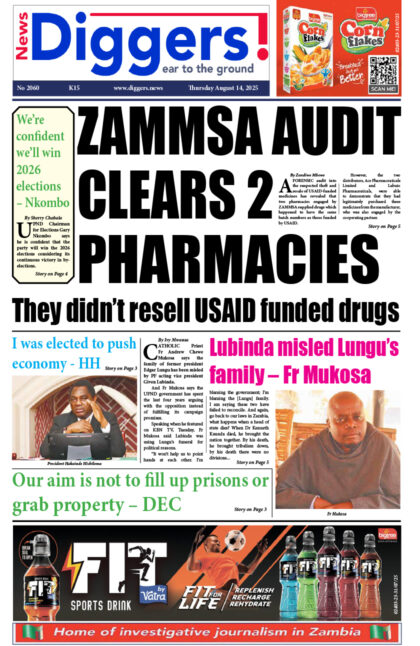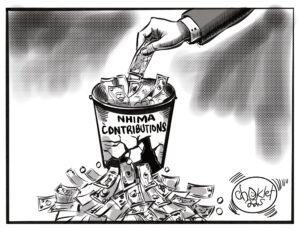ZAMBIA’S economy severely contracted by an unprecedented 2.1 per cent in the second quarter of 2020, triggered by the COVID-19 pandemic, which slashed productivity across various sectors, market data shows.
But the mining and ICT sectors remained resilient and registered positive growth amid the Coronavirus onslaught, raising hopes of economic recovery.
According to a Zanaco Economic Review and Outlook monthly report, released this month, Zambia’s GDP severely contracted by an unprecedented 2.1 per cent in the second quarter of 2020, triggered by the COVID-19 pandemic, which slashed productivity across various sectors.
“Housing three of the worst months on record as regards the pulse of economic activity among private sector firms, Zambia’s GDP contracted 2.1 per cent in Q2, 2020, seven times deeper than the mild contraction of 0.3 per cent recorded in almost COVID-free Q1,” the report, compiled by the bank’s economic research team, read.
Data showed that wholesale and retail trading and construction, among others, felt the heaviest impact of the COVID-19 pandemic once the virus outbreak emerged in Zambia in March, this year.
“Prior to the outbreak of the pandemic in Zambia, the largest contributor to the economy’s GDP had contracted by 9.6 per cent in both Q4, 2019, and Q1, 2020, at the time when talks of job losses and diminishing customer numbers in trading corridors were already commonplace. With COVID-19 in the picture, the foregoing challenges deepened and access to supplier markets abroad nearly diminished and delivery times lengthened by multiples of usual waiting times. Local measures that restricted unnecessary movements met with people’s anxiety and fears in sinking consumer demand for a highly income-sensitive sector. As a result, trading output in the economy plunged 18.3 per cent, thereby, contributing -3.7 per cent in shrinking the economy in Q2. The most heat was felt by those trading in non-essential items because consumers redefined their shopping basket to a necessity-dominant one,” Zanaco explained.
“The economic activity pains for the construction sector which has been on the contraction path for seven consecutive quarters nearly doubled after diving 16.8 per cent in Q2 compared to 8.5 per cent suffered in Q1. With taxes plummeting 18.3 per cent owing to a shrinking economy, government slowed on construction activity coming from suspension of all works below 80 per cent of completion earlier in 2019. The rout on the kwacha and electricity supply challenges (plus upward adjustment in electricity prices) sent the price of cement to ZMW108.12 per 50Kg bag at end of June, up by 40 per cent from ZMW69.24 a year before. As such, and with a Q2 skew, cement sales volumes at Dangote and Lafarge were down 30 per cent and nine per cent (y/y) during the first half of the year respectively. Overall, this resulted in an 18 per cent reduction in Zambia’s cement market in manifestation of the responsiveness of the construction sector to the e™ect of the pandemic and the longstanding challenges.”
The tourism and hospitality sector equally suffered a heavy blow from reduced numbers of tourists and slashed economic activity.
“Providers of accommodation and food services were the third largest contributor to the Q2 contraction after shrivelling 30.4 per cent (y/y) from 8.9 per cent in the preceding quarter. Disappearance of international arrivals, home confinement of local consumers (both forced and voluntary) and subsequent cancellation of meetings and conferences were the key drivers of the meltdown in one of the first sectors to be hit by the pandemic woes,” it stated.
But the mining and ICT sectors remained resilient and registered positive growth amid the Coronavirus onslaught, raising hopes of economic recovery.
“Even in the thicket of the pandemic woes, there were some sectors that came out as outstanding performers, thereby, easing the extent to which Zambia’s real GDP contracted in Q2. Thriving on a positive shock to demand as an enabler of teleworking and tele-socialisation, ICT activities led the pack of points from 20.7 per cent in Q1. Other sectors that registered growth were mining/quarrying, agriculture/forestry/fishing and financial services following output expansions of 14.2 per cent (from a two per cent contraction in Q1), 22.9 per cent (from a 24.6 per cent growth rate in Q1) and 17.5 per cent (vs Q1’s 8.9 per cent),” stated Zanaco.
“Encouraged by recovering copper prices after surging over 26 per cent to US$ 6,037.85/MT at close of June from US$ 4,785.25/MT on April 1, mining firms responded by exporting 2.8 per cent more copper volumes in Q2 at 217,057.4 MT compared to 211,078.3 in the same period last year. In fact, the mining/quarrying was the only sector to have rebounded to positive growth among Meanwhile, the agriculture sector proved resilient as a supplier of essentials at the back of good rainfall in the last rain season, while providers of financial services leveraged on digital agriculture and finance sectors slowed the recession by a combined sum of 4.9 per cent.”
























